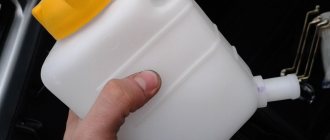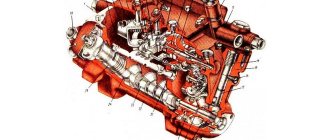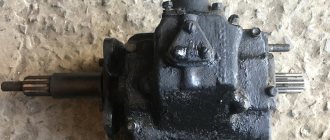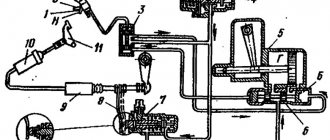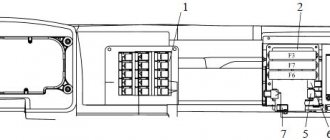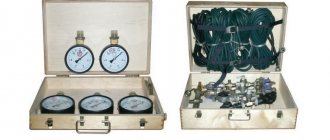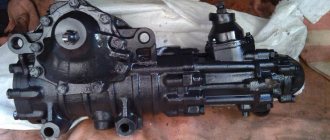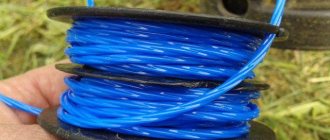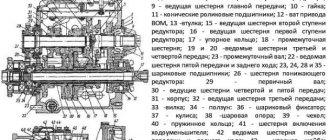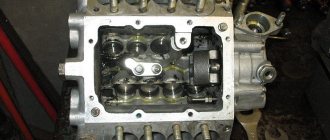Hello everyone! I traveled on the last two flights myself, and since it’s cold at night now, I almost froze on these two flights)). Today I decided to sort this matter out and at the same time repair the pump. We drove around all summer with water in the radiator (((, so the whole system became rusty. I removed the heater radiator and poured a bottle of Domestos into it
and set it to cool, in the meantime I prepared a system for flushing the radiator, poured water into the tank and lowered the “Rucheyok” water pump into it, then hooked it up to the radiator, looped it in a circle and drove the water with Domestos for half an hour. The water became rusty (mother, don’t worry ), I've never seen such shit before!
Then I washed it with running water. Next, I drained the water from the Kamaz, poured a second bottle of Domestos into the coolant system, added water and also drove for about half an hour, drained everything, the water was also red with rust.
I flushed the system again three times, the last time the water was almost clean.
Then I took hold of the pump, as I wrote in the previous on-board article, it began to leak a little when cold. I took off the belt and twiddled the pulley and it was hanging loose ((. I repaired it in April of this year! It looks like the water is doing its nasty nasty thing. It’s good that, as always, there is something in stock)). I took out another pump, opened it, I checked it for integrity and put it back together, cleaning it a little from dirt and painting it silver.
I put it in place, filled it with water again to check, started it, drove it and drained the water again, the pump does not run! I put the heater radiator in place and screwed on an additional nozzle for the second radiator.
I’ve had it lying around for three years already, a friend picked it up, but I still can’t buy a second radiator)), now I’m thinking of buying it. They say that with a second radiator, the socks on my feet begin to melt)). I replaced all the hoses going to the stove, because they were very tired, the supply of which was stratified from the inside and did not allow coolant to pass through well, and the return one was full of cracks((. I went to the store, bought 5 red Antifreeze canisters of 5 kg each, and in liters there will be 20l.
I filled it up and it turned out to be not enough((, the store was already closed((, I had to go to the gas station and buy an expensive freezik there, also a 4-liter canister,
I filled it up, and again it won’t be enough ((, somewhere around 3 liters is not enough to the norm. I gave up on this matter, next time I’ll buy more and fill it up, because I got tired of changing clothes. Along the way, I replaced the burst knee of the air intake, the tires were bad, they changed them in the spring and again twenty-five ((.
At the end of all the procedures, I decided to wash the engine and its surroundings a little, Karcher is really already half-dead, he’s not pressing shit ((, he doused the whole thing with oil from the return line to soak off thick layers of dirt and then washed the whole thing off with a car wash. Then he wet the engine with car shampoo and washed it again , not everything came off ((due to a dead sink.
In the evening there was no more run for hay, with a trailer. The stove heats the Fire! True, it was +9 degrees outside. Good luck everyone!
Issue price: 2,000 ₽
Operating principle and repair manual for a pump for KamAZ
The water pump of the engine cooling system is designed to create forced circulation of coolant (coolant). The KamAZ pump is located in the front part of the left cylinder block and is driven by rotation transmitted from the engine fluid coupling pulley via a belt drive. Failure of the pump leads to boiling of antifreeze and failure of the entire engine. Monitoring the level and quality of coolant will help ensure the pump is in good condition.
Diagram and components of the water pump for KamAZ 740 engines
The water pump (pump) of the KamAZ 740 engine is mounted on the front left part of the cylinder block. For fastening to the block, the pump body has three holes for bolts. Repair of the pump may be required if it loses its seal and leaks coolant, as well as if the water pump shaft is jammed.
1. Pulley 2. Dust deflector washer 3. Retaining ring 4. Bearings 1160305-A and 1160304-K 5. Shaft key 6. Water pump shaft 7. Water pump cuff 8. Water pump housing 9. Oil seal 10. Thrust ring 11. Ring sealing 12. O-ring race 13. Impeller 14. Oiler 15. Pump plug
To dismantle the pump for repair work:
- drain the coolant,
- remove the drive belts from the pulley,
- remove the three fastening bolts,
- disconnect the water pipes.
Design and principle of operation
The water pump is a centrifugal type pump, which consists of:
- housings;
- shaft;
- 2 ball bearings;
- mechanical seal;
- impellers;
- pulley
The cast body is made of cast iron or aluminum and has 2 pipes: the suction pipe is connected to the radiator, and the pressure pipe is connected to the cylinder block jacket. This connection diagram makes it possible to pump liquid already cooled in the radiator.
There are 2 holes on the pump body: the upper one is used to ventilate the cavity of the bearing assembly, and the lower one is intended to control antifreeze leaks if the seal is not sealed; it simultaneously serves as drainage.
Bearings are lubricated during operation through a special device (grease gun).
Due to the fact that the pump drive is mechanical and directly connected to the engine, the coolant circulation speed depends on the engine speed. The higher the rotation speed, the more intense the cooling. The mechanical seal is designed to prevent antifreeze from entering the hydraulic (water) cavity into the bearing assembly. It is installed on a shaft and consists of a moving and a stationary (rotating) part. Tightness is ensured by graphite sealing surfaces, onto which graphite lubricant is applied.
To create a tight connection, a spring is installed on the moving part of the sealing device. Over time, graphite surfaces wear out and lose their seal. In this case, it is possible to replace them. The impeller is placed on the pump shaft and secured with a nut. The pump is installed on the cylinder block on a special gasket that reduces vibration.
Cooling system KamAZ 5511
The engine cooling system serves to maintain a certain temperature of the metal body of the motor. It is believed that normal heating should not exceed 100 o C, i.e. the boiling point of water. When calculating and adjusting the thermal clearances of valves, it is precisely this heating that is taken into account. An increase or decrease in temperature entails an expansion or narrowing of the exhaust gas outlets and affects the overall power. Excessive fuel consumption occurs. That is why, before starting operation, engines are always warmed up to a temperature of 90–95 o C.
Location of coolant circulation channels inside the engine
In addition to the water pump, the cooling system includes:
- radiator located in the front of the car (for better airflow);
Coolant is cooled inside the radiator
The expansion tank serves for free circulation of coolant inside the cooling system
The hot coolant transfers heat into the passenger compartment using a radiator blown by a fan
The thermostat is responsible for maintaining the temperature at the same level
The system is closed and fully automatic. Manual control is installed only on the “stove” of the cabin: the driver can independently adjust the heating level inside the cabin.
The system is monitored using an engine temperature sensor located in the motor housing. The sensor readings are displayed on the temperature indicator located on the dashboard.
Thus, all elements that make up the cooling system operate in static mode.
The only exception is the water pump, which rotates continuously while the engine is running. It is for this reason that the probability of pump failure is higher than that of other elements of the cooling system.
Location of the water pump on KamAZ
The location of the water pump is determined by the drive mechanism. Rotation is transmitted to the pump pulley from the crankshaft using V-belts. In accordance with this, its location is the left front part of the cylinder block. The design feature is that the forced air fan is located on the fluid coupling, and not on the pump pulley itself.
The water pump is located in front of the engine, on the left - footnote No. 2
Water pump device
The KamAZ automobile pump consists of the following parts:
- Pump drive pulley, rotating using V-belts. The pulleys are different in different KamAZ models. Therefore, you need to pay attention to how many belts the pulley rotates (1 or 2). Modern cars are equipped with a drive consisting of 2 belts. This increases the level of engine reliability.
- A retaining ring that secures the drive to the impeller shaft. It operates on the principle of pinching a pulley in a certain position.
- A support bearing consisting of two rows of roller bearings. The inner surface of the bearing is filled with a special indelible lubricant. You can renew the lubricant using an oil can - a syringe, filling the rubbing parts before squeezing out the used lubricant through a special hole.
- Pump shaft: a steel rod on which the impeller is mounted.
- Metal cast pump body.
- End seal to prevent coolant leakage. It consists of a rubber seal, which is pressed by a washer to the pump body with a spring. Rotates with the shaft.
- Impeller made of steel.
KamAZ 5511 water pump device
Malfunctions and repairs
The cause of the water pump malfunction is the loss of tightness of the mechanical seal. After hot coolant enters the cavity of the bearings, the lubricant is washed out of the latter. After a while the pump starts to rattle and then jams. Self-diagnosis allows you to identify such a defect by antifreeze leakage from the control hole, shaft play, and in winter - by a decrease in the efficiency of the cabin heater.
Restoring the pump's functionality can be done through a unit replacement. But most drivers repair the KamAZ pump with their own hands. If the spare parts kit contains the necessary parts or the shaft assembly, then repairing the pump is not difficult at all. To do this, it is necessary to remove the pump from its original location, disassemble and replace defective parts. A distinctive feature of the KamAZ Euro water pump is that the blower fan is mounted not on the pump pulley, but on a fluid coupling.
How to remove and disassemble
Dismantling the pump is not difficult. Before starting work, it is necessary to drain the coolant. It must be remembered that antifreeze is toxic and can harm the environment. Therefore, it needs to be collected in a container. Clean coolant after filtration can be reused. To remove the drive belts, you need to loosen their tension. After draining the coolant, remove the clamps securing the antifreeze supply pipes.
The pump is attached to the block with 3 bolts. Having unscrewed them, remove the pump assembly from its regular place and take it out along with the coolant supply pipes to the thermostat and fluid coupling. To disassemble the water pump, remove the pulley and impeller fasteners. To remove the shaft with bearings and seal, use a drift made of soft material. If necessary, disassemble the defective unit and install functional parts from the repair kit.
How to change
KamAZ trucks use pumps with single- and double-strand pulleys. If there is a need for a unit replacement, then you need to buy a pump that is a complete analogue of the previously installed one. Otherwise, there is a high probability of a repeat defect. The pump is replaced in the reverse order of removal. Before installing it, it is necessary to fill the cavity of the bearing unit with grease until the latter appears in the control hole. This will make it difficult for antifreeze to enter if the seal breaks.
Do-it-yourself pump replacement on VAZ cars
As mentioned above, the replacement procedure will look different on different car models. This is due to the location of the unit in the engine compartment and the design of the car itself. The easiest way to perform the replacement is on VAZ cars.
To replace the pump you only need wrenches
The replacement procedure is as follows:
Wait until the engine cools down. It is prohibited to carry out work immediately after stopping the engine, as you may get burned.
Prepare a set of wrenches and a container to drain the old coolant. It is necessary to change the pump together with antifreeze (antifreeze), since the old liquid gradually loses its cooling properties during use.
Unscrew the antifreeze drain plug (the plug is located on the engine block). After this, unscrew the cap on the radiator to quickly get rid of the old fluid. Place containers under the drain points.
When the antifreeze (antifreeze) stops dripping, loosen the generator belt tension rack. After this, remove the belt, since otherwise it will be impossible to get close to the pump.
Remove the three pulley bolts.
Remove the alternator belt pulley.
Unscrew the nuts that secure the part to the motor housing.
Take out the pump and along with it the old gasket.
After this, it is recommended to wipe the seating area with a clean cloth and install a new rubber gasket. To ensure secure fastening, it is better to treat the socket with sealant.
Install the new pump on a new gasket and then carry out all work in the reverse order.
Upon completion of work, fill in new coolant.
Video: how to replace the water pump on a VAZ
Dismantling and installation of the product on VAZ cars takes about an hour. On cars of other brands, the work may take longer due to the fact that you will have to unscrew the engine mounts.
How much does it cost to replace a pump at a service station?
It is necessary to separately say that replacement in itself is not a costly operation. Specialists from service organizations charge from 1,200 to 3,000 rubles for their services, depending on the make of the car.
I changed it myself on a 124 engine, I changed it on an 8-valve engine with a friend on his ten... I still don’t understand what the 1200 came out of... Whatever it was, it took an hour with breaks. I’ll even say more - I recently changed the pump itself on the m50b20 in my BMW, it took about 40 minutes.. The service asked for inadequate money for this work... Although in fact it’s easier to change the pump on a BMW than on the former 21124..
Ten Kens
https://www.nn.ru/community/auto/vaz/skolko_stoit_menyat_pompu_na_vaz_2110.html
If you consider that the pump itself costs several hundred rubles and has to be changed extremely rarely, then you can afford the pleasure of turning to a workshop for services.
How much does a pump and its repair cost?
The price of the pump depends on the manufacturer, engine model and region of the country. Its cost ranges from 5 to 15 thousand rubles. Refurbished products are sold in the range of 2-2.5 thousand rubles. Do-it-yourself repairs will cost much less, since a repair kit can be bought for 600-700 rubles. This will more than cover even a complete replacement of antifreeze. If the pump body is without flaws and the impeller is not damaged by cavitation corrosion, then it makes sense to replace the defective parts yourself.
It must be remembered that the use of high-quality coolant and periodic maintenance will significantly extend the service life of the pump.
Is it possible to drive if the pump is jammed?
Many car owners are concerned about the question: is it even possible to operate the car if the pump does not work? And if so, what is the best way to drive?
The whole thing comes down to two components:
How necessary is it to use the car?
Of course, if the pump is jammed, the circulation of antifreeze in the system will be disrupted. Accordingly, the engine can only be cooled naturally. Therefore, it is better not to start the car, since overheating of the engine brings certain death to your four-wheeled friend. However, it is allowed to drive a faulty car if it is cold outside. The engine is less susceptible to overheating, but you should avoid traffic lights and forced stops, as the engine heats up faster due to changes in the number of revolutions.
That is, most problems with the pump can be solved on your own. With the affordable cost of this pump, you can change the pump immediately when necessary. However, experienced drivers do not make a replacement until the product begins to act up. Practice shows that the pump's service life is much higher than stated by the manufacturer. Therefore, you don’t have to worry about repairs and replacements if the cooling system is operating normally.
How to remove a pump on a KAMAZ
The water pump, which is located in the KAMAZ internal combustion engine, is responsible for ensuring uninterrupted operation of the cooling system in any vehicle.
The cooling system protects the car engine from overheating, which protects against irreversible deformation of the metal, damage to the integrity of the gasket and depressurization of the engine. To avoid the unpleasant and costly consequences of overhauling a KAMAZ, it is necessary to promptly identify defects in the pump and quickly replace it.
The main signs of a pump malfunction
It happens that the main systems of your KAMAZ are working properly, however, the indicator shows increased engine temperature. In this case, first of all, you should pay attention to the proper operation of the water pump. Below we will look at the main signs indicating a pump failure:
- A broken pump produces a characteristic sound, which, with increasing speed, changes from a slight howl to a sharp squeal.
- Presence of specific leaks in the area of the water pump.
- During the cold season, the car interior does not heat up well.
Guide to removing the pump on KAMAZ
In order to remove the pump without additional difficulties, you should make sure that two conditions are met, which are as follows:
- Allow the engine to cool down;
- It is necessary to drain the coolant (antifreeze);
- Use a lift to raise the cabin.
Important! Under no circumstances should antifreeze be poured onto the ground, as it contains harmful synthetic substances that poison all living things. Therefore, it is worth taking care in advance to prepare a special large-volume container (about 20 liters) to drain all the coolant into it.
How to remove a pump on a KAMAZ
The water pump, which is located in the KAMAZ internal combustion engine, is responsible for ensuring uninterrupted operation of the cooling system in any vehicle.
The cooling system protects the car engine from overheating, which protects against irreversible deformation of the metal, damage to the integrity of the gasket and depressurization of the engine. To avoid the unpleasant and costly consequences of overhauling a KAMAZ, it is necessary to promptly identify defects in the pump and quickly replace it.
The main signs of a pump malfunction
It happens that the main systems of your KAMAZ are working properly, however, the indicator shows increased engine temperature. In this case, first of all, you should pay attention to the proper operation of the water pump. Below we will look at the main signs indicating a pump failure:
- A broken pump produces a characteristic sound, which, with increasing speed, changes from a slight howl to a sharp squeal.
- Presence of specific leaks in the area of the water pump.
- During the cold season, the car interior does not heat up well.
Do-it-yourself water pump repair
The car's designers declared a maximum mileage of 800,000 kilometers for a new car. However, there are a number of reasons that significantly reduce the warranty mileage.
These are factors such as:
- harsh operating conditions;
- presence of significant overloads;
- sudden temperature changes.
As a result, the pump can travel approximately 60,000 kilometers. And even in this case, regular maintenance of the device is expected.
Experts consider the most common motor pump malfunctions to be:
- cracks, chips on the pump body;
- significant wear or bending of the geometry of the working shaft of the water pump;
- complete mechanical wear of the rubber seal;
- wear of bearing components.
In ensuring long-term operation of the motor pump, the cooling liquid, in particular its quality, has a huge influence. Motorists know that the use of antifreeze is designed for 30,000 kilometers or two years of continuous operation. After the stated warranty period, the internal properties of the antifreeze may change significantly. Its anti-corrosion and lubricating properties deteriorate significantly.
Experts do not recommend mixing coolant with water; you can only add another coolant, but one that is compatible by brand
More than other components of the pump, the impeller, which is constantly in contact with antifreeze, suffers from this, as well as the cooling radiator. They are covered with a layer of rust. Its flakes clog technological ducts, as well as all rubbing parts. This circumstance causes premature wear of absolutely all components of the engine CO.
However, such a pump has a high degree of maintainability. This means that any failed parts in the mechanism can be replaced, and even a novice car mechanic can disassemble the water pump. Using electric welding equipment or special two-component sealants (for example, epoxy resin), the casing and impeller are repaired.
The glue can be prepared by mixing its components in the required proportions, according to the attached instructions
This eliminates:
- cracks;
- chips;
- other mechanical damage.
A water pump drive shaft that has lost its geometric dimensions can be repaired as follows:
- Leveling using a press.
- By applying a layer of chromium to the part and then mechanically finishing it to obtain the required dimensions.
Only the rubber seal is not subject to repair. However, it is very simply and easily removed from the pump, which allows for its quick replacement.
Diagnostic measures to determine problems in the system
Before starting pump repairs, it is recommended to verify the reliability of the data that the actual cause of failures during engine operation is this mechanism.
The main indicator indicating a malfunction of any components in the cooling system is the fact of a significant increase in the temperature of the motor during normal operation. In this case, the temperature indicator will register a coolant temperature of more than 100 °C.
The reasons for this temperature fluctuation are:
- Possible coolant leak. The fact that coolant leaves the system is determined visually by control marks on the expansion tank, where there are special marks indicating the minimum and maximum levels of antifreeze in the entire coolant. A level below the minimum value indicates a possible leak that needs to be detected.
- The temperature sensor may be faulty. In this case, the water pump turns out to be fully operational, although the indicator will show engine overheating. The temperature sensor in this case requires replacement.
- Cooling radiator malfunctions. This component may be excessively dirty or damaged. For example, the presence of a large amount of dust and dirt that adheres to the walls of the radiator can lead to significant overheating of the power unit. To resolve the issue, just rinse the device thoroughly.
- Problems with the thermostat. A thermostat failure may result in the coolant temperature not rising above average values. This fact is a consequence of the fact that the coolant circulates only in a large cooling circle, which also does not benefit engine parts, but overheating in this case is not observed. If the thermostat mechanism was jammed in the opposite position of the valve (“small circle”), then a sign of this breakdown is a complete lack of heating in the truck cab. It can be observed that the coolant begins to boil during vehicle operation even in the expansion tank.
Guide to removing the pump on KAMAZ
In order to remove the pump without additional difficulties, you should make sure that two conditions are met, which are as follows:
- Allow the engine to cool down;
- It is necessary to drain the coolant (antifreeze);
- Use a lift to raise the cabin.
Important! Under no circumstances should antifreeze be poured onto the ground, as it contains harmful synthetic substances that poison all living things. Therefore, it is worth taking care in advance to prepare a special large-volume container (about 20 liters) to drain all the coolant into it.
Next, you need to carry out the following manipulations:
- First you need to loosen the power steering pump mounts.
- Unscrew the bolts until the alternator belt comes loose.
- Now we can easily remove the generator drive belt.
- Next, unscrew the bolts to which the pump is attached using a wrench.
- Carefully, tapping with a hammer, remove the pump.
As can be seen from the description, removing the pump is not difficult, the main thing is to follow the entire sequence of this procedure. Since the KAMAZ pump is the most moving part in the engine cooling system, this spare part is most often susceptible to damage, which means it requires regular inspection in order to protect you from unplanned expenses.

